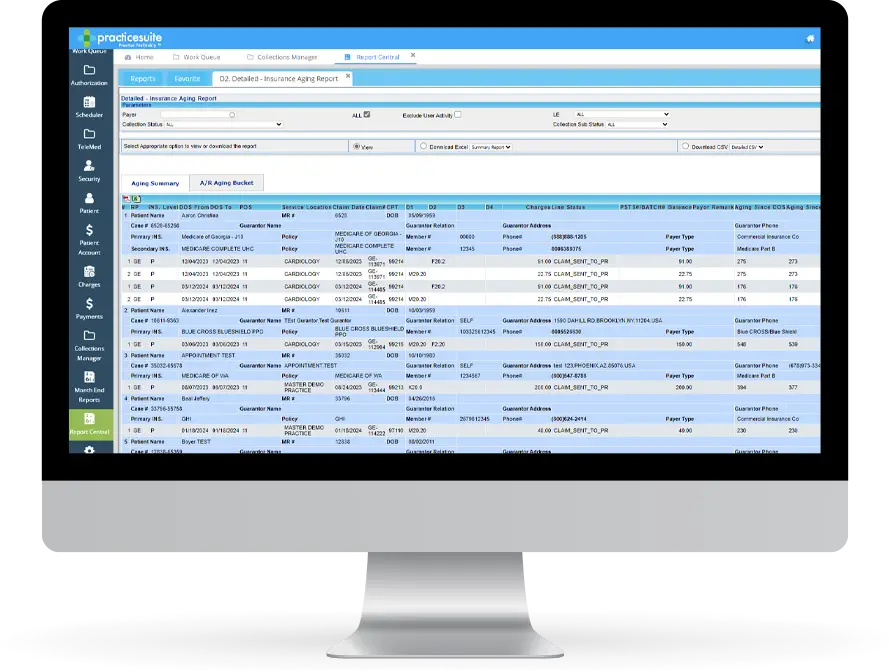Revenue Cycle Management Software for Medical Practices
Partner with PracticeSuite to transform your revenue cycle management (RCM) processes and effortlessly secure payments. From medical coding to claim management to insurance verification, we have all the tools you need to manage all revenue cycle stages.

Advanced Revenue Cycle Management to Drive Growth
Revenue cycle management is the optimization of the revenue cycle, which begins when a patient calls for a medical appointment and ends when the final bill is paid. PracticeSuite unites your RCM expertise with our elite software to create tremendous value for your organization and clients.
We Offer:
Comprehensive Medical Billing
Free up time and resources by using PracticeSuite’s software to streamline and accelerate your entire revenue cycle, from patient payments to final insurance reimbursement. Plus, monitor your billing performance in real-time with up-to-the-minute dashboard reporting and key performance indicators (KPIs).
Increase Reimbursements
PracticeSuite’s revenue cycle management software ensures you receive every penny you're owed. With our RCM solution, we tirelessly resolve denials, manage appeals, address underpayments, and navigate recoupment processes, all to maximize your reimbursements and minimize any financial stress.
Optimal Payment Cycle
Accelerate your payment cycle with improved first-pass claim acceptance and automated remittance posting. Our RCM solution manages complex processes, streamlining interactions and resolving payment issues promptly.
Revenue Cycle Management Software Features
Achieve extraordinary results with PracticeSuite, using robust features that cover all RCM processes, from managing your enterprise’s financial health to tackling demanding medical billing needs.
Enterprise Claims Management
Handle coding, filing claims, rejections, denials, and more across all clients in one RCM solution. Plus, make mass claim corrections if necessary to improve claim acceptance.
Insurance Verification
No more worrying about how much patients should pay for their visit. Verify patient insurance eligibility immediately to know precisely how much to charge for their co-pay and other fees.
Patient Collections
With PracticeSuite’s revenue cycle management software, you’ll establish a straightforward and convenient payment process to promote timely patient collections.
Central Billing Office
Navigate billing accounts for all patients across multiple practices. Leverage single sign-on (SSO) so you can always access the data you need—no silos here!
Specialty-Specific
Our revenue cycle management software works with over 150 billing specialties and over 60 clinical specialties—no matter your unique needs, we have the tools to address them!
KPI Dashboard
Monitor your revenue cycle management performance in real time with a single centralized dashboard that shows rejections, denials, payments, key performance indicators, and more.
Financial Reporting
Analytical reporting is key to achieving long-term financial stability, operational excellence, and improved care quality. PracticeSuite’s revenue cycle management software gives you access to all the data you need to make informed decisions.
Cloud-Based
With a cloud-based RCM tool, your operations aren’t bound by your physical location, so managing data across practices is easy. Access your financial information through any device or browser at any time convenient for you.
Robust Customer Support
Our RCM software speaks for itself, but we are most proud of our support excellence. Experience reliable, stellar customer support you can shout about from the rooftops.
- All-in-One Software for Medical Practices
With PracticeSuite, you’re not just getting access to feature-filled revenue cycle management software. We go beyond RCM tools and provide everything you need to seamlessly manage your entire medical practice.
Our Satisfied Customers Say It Best

Hassle-free RCM starts here.
Try PracticeSuite’s solution for effortless financial health management.

